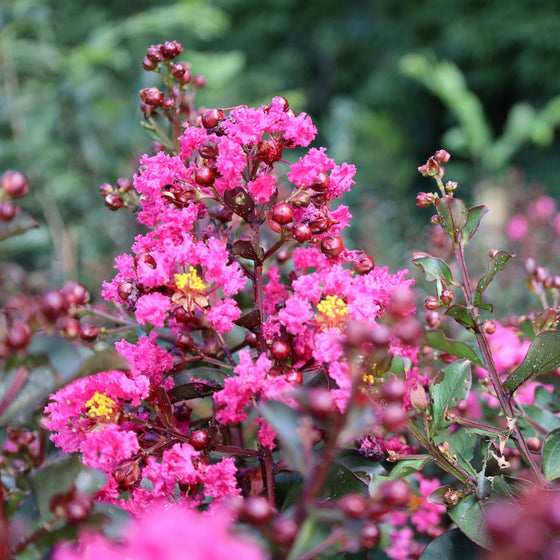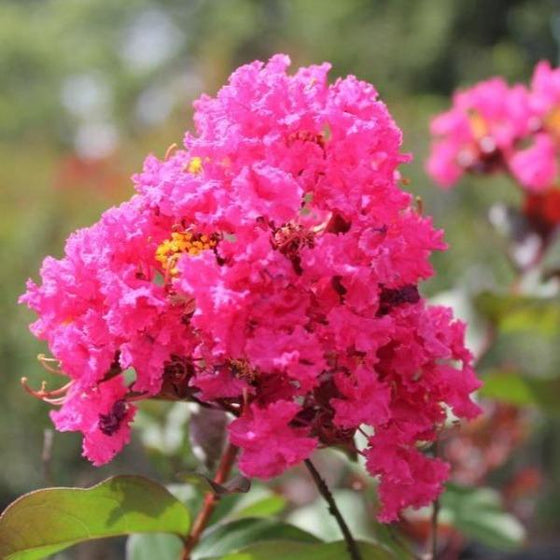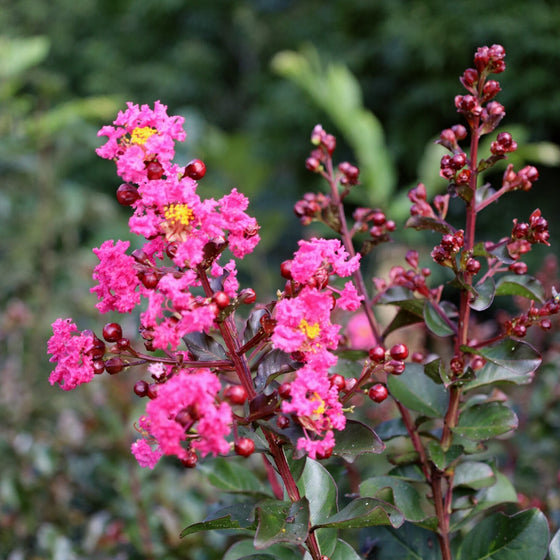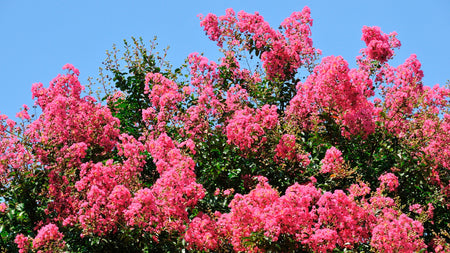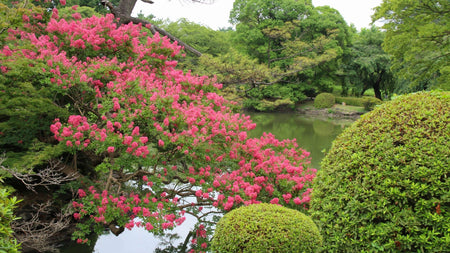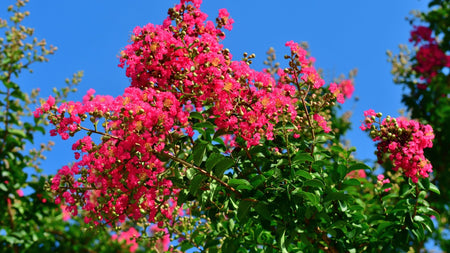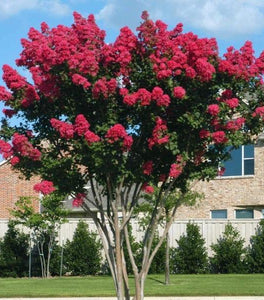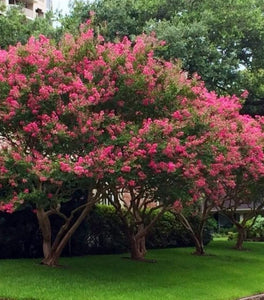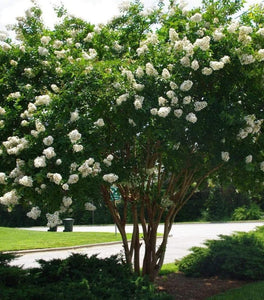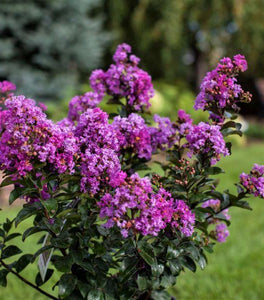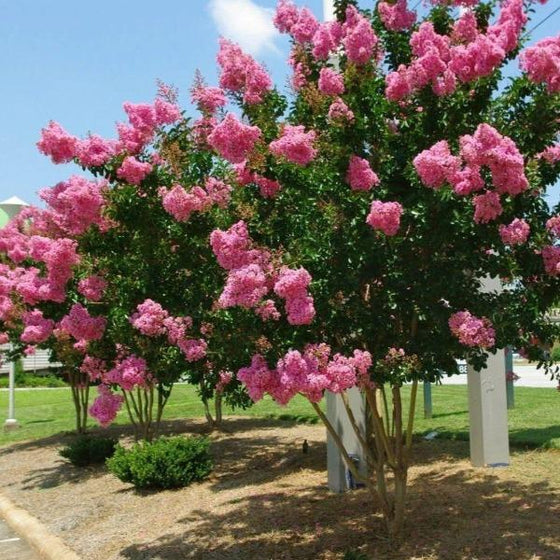
Images Depict Mature Plants
Pink Velour Crape Myrtle – Compact Pink Flowering Tree with Brilliant Blooms and Burgundy Foliage
Color that stops traffic—season after season.
The Pink Velour Crape Myrtle turns heads with its vibrant, magenta-pink blooms, which shine for more than 100 days each summer. This compact variety was bred for its intense flower color and exceptional resistance to powdery mildew, making it a popular choice among gardeners in the South and Mid-Atlantic. Its rich burgundy new growth matures into glossy green foliage, offering a striking contrast to the brilliant blooms.
Compact beauty for any space.
Reaching a manageable 6 to 10 feet tall and 5 to 6 feet wide, Pink Velour fits beautifully into small yards, patios, and foundation plantings. It’s large enough to make a statement yet compact enough to control easily. Whether you plant it as a stand-alone accent or line a driveway with its rosy blooms, Pink Velour delivers a burst of color that endures from summer through fall.
Built to handle heat, humidity, and drought.
Developed in the heat of Oklahoma, Pink Velour was selected for its heat tolerance and low-maintenance durability. Once established, it’s drought-tolerant and thrives in full sun with minimal care. This makes it ideal for busy homeowners who want lavish color without the need for constant watering or pruning. Its hybrid heritage also provides exceptional resistance to common Crape Myrtle diseases, such as leaf spot and mildew.
Four seasons of beauty in one Crape Myrtle.
Beyond its summer flowers, the Pink Velour Crape Myrtle offers year-round interest. In fall, its foliage deepens to bronze-red before shedding to reveal smooth, mottled bark for winter texture. Few flowering trees deliver this much color with so little effort—making Pink Velour a true landscape workhorse that thrives for decades.
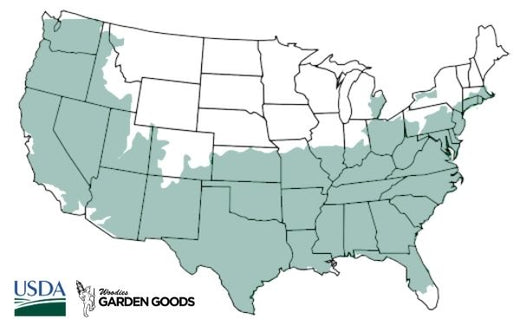
| Hardiness Zone: | 6-9 |
|---|---|
| Mature Height: | 6 to 10 feet |
| Mature Width: | 5 to 6 feet |
| Classification: | Tree form small to mid-sized (5 to 10 feet) |
| Sunlight: | Full Sun |
| Habit: | Deciduous, densely branched, multi-stemmed habit |
| Flower Color: | Bright Magenta Pink flowers |
| Foliage: | New growth emerges a deep wine red changing to deep purple-green, then changes again to a equally vibrant orange-red in the fall |
| Soil Condition: | Any well drained soil |
| Water Requirements: | Water well until established |
| Uses: | Extremely attractive when used as a focal point in the mixed border, mass planting, or a specimen planting. Also try them in large containers on the patio |
How to Care for Pink Velour Crape Myrtle
Before you buy a Pink Velour Crape Myrtle, make sure to read about the care instructions that are required and recommended to keep this plant healthy and flourishing.
How do I plant a Pink Velour Crape Myrtle?
Choose a sunny spot with at least 6 hours of direct sunlight daily. Dig a hole twice as wide as the root ball but no deeper. Place the tree so the top of the root ball is even with the soil surface, backfill with native soil mixed with compost, and water thoroughly. Add a 2-inch layer of mulch around the base to retain moisture and regulate temperature. Avoid wet or poorly draining areas to prevent root rot. Proper planting sets the stage for healthy growth and abundant blooms.
How often should I water my Pink Velour Crape Myrtle?
Water deeply once or twice per week during the first growing season to encourage strong roots. After it’s established, this variety is highly drought tolerant and needs only occasional watering during extended dry spells. Avoid frequent shallow watering, which encourages surface roots. Mulching will help retain moisture and keep the roots cool during summer heat spikes.
When should I fertilize my Pink Velour Crape Myrtle?
Feed once in early spring using a slow-release balanced fertilizer (10-10-10) before new growth appears. A light midsummer feeding can extend the bloom season into fall. Avoid over-fertilizing, which can cause excess foliage growth at the expense of flowers. Incorporating compost annually keeps the soil rich and encourages vivid color and vigorous growth.

How and when should I prune a Pink Velour Crape Myrtle?
Prune in late winter or early spring before new growth starts. Remove dead or crossing branches and shape lightly for balance and structure. Avoid “Crape Murder” (topping), as it weakens branches and reduces bloom potential. Because Pink Velour blooms on new wood, light annual pruning encourages a fresh flush of blooms each year and maintains its rounded, compact form.


